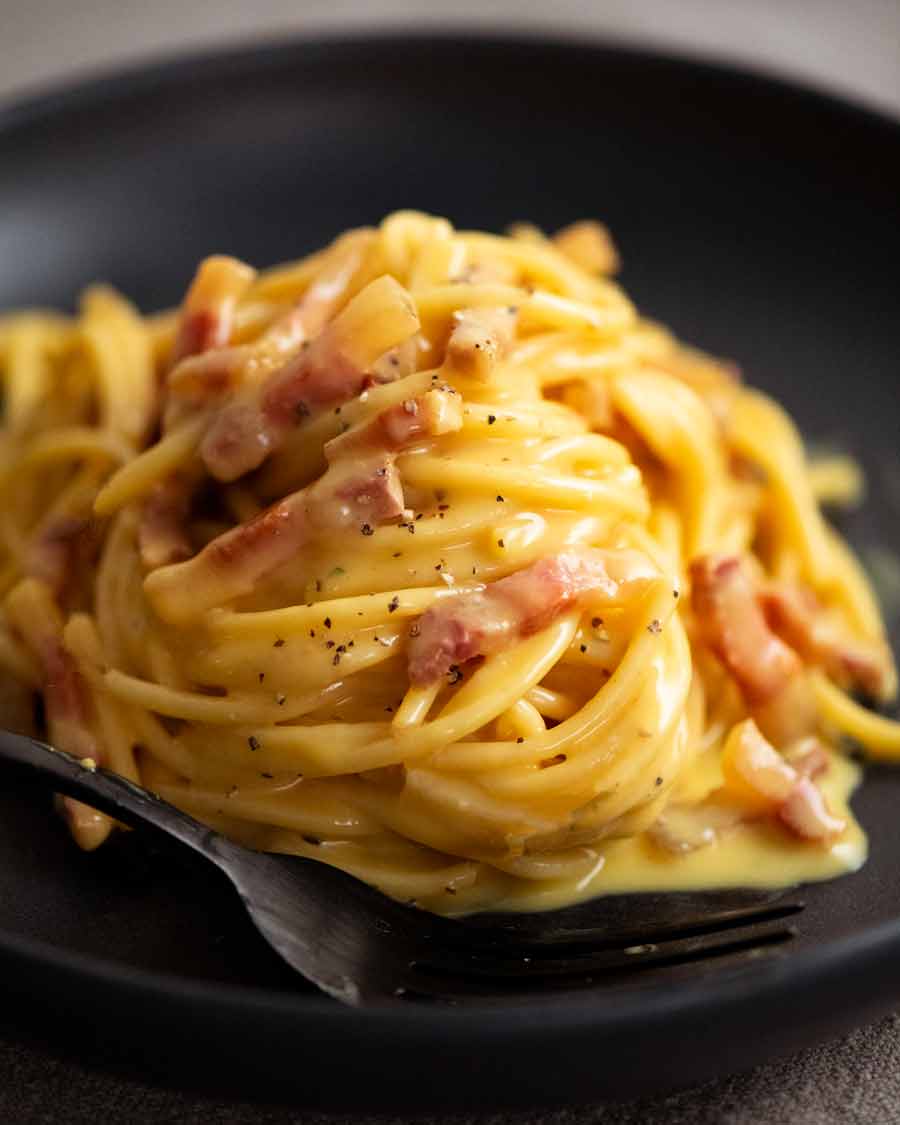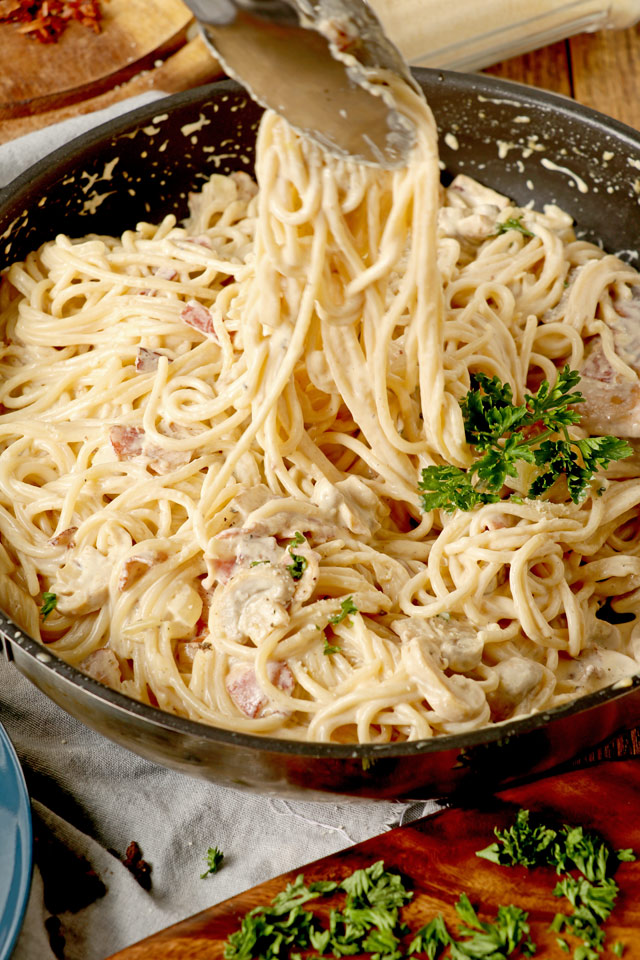A Love Story in a Bowl: The Enduring Allure of Pasta Carbonara
Related Articles
- Mastering The Art Of French Pastry: From Croissants To Mille-Feuille
- Exploring Brazilian Churrasco: Mastering Grilling Techniques For Perfect Meat
- How To Master The Art Of Sushi Making: Techniques From Japanese Chefs
- Exploring The Rich Flavors Of Authentic Sichuan Hot Pot: A Must-Try Experience
- A Culinary Journey Through The Middle East: Shawarma, Falafel, And More You Can Make At Home
Introduction
In this article, we dive into A Love Story in a Bowl: The Enduring Allure of Pasta Carbonara, giving you a full overview of what’s to come
A Love Story in a Bowl: The Enduring Allure of Pasta Carbonara

Pasta Carbonara. The name itself evokes images of creamy, cheesy goodness, a symphony of textures and flavors that tantalizes the palate. But beyond its simple elegance lies a story, a rich tapestry woven from tradition, history, and the very soul of Italian cuisine. This isn’t just a dish; it’s an experience, a journey through time and taste, one that captures the essence of Italian life.
From Humble Beginnings to Global Phenomenon:
Carbonara’s origins are shrouded in mystery, a testament to its enduring popularity and the inevitable evolution of culinary traditions. While the exact birthplace remains a subject of debate, most agree that it hails from the central Italian region of Lazio, specifically the area around Rome.
The early 20th century saw the rise of carbonara, likely born from the simple, rustic kitchens of rural Italy. The dish’s foundation lies in the post-war period, where the scarcity of ingredients forced cooks to be creative. Guanciale, a cured pork cheek, became a staple due to its availability, and its salty, smoky flavor added depth to the otherwise simple dish. Eggs, readily available, provided a rich, creamy texture. The addition of Pecorino Romano, a sharp, sheep’s milk cheese, completed the flavor profile, creating a harmonious blend of salty, savory, and slightly tangy notes.
A Tale of Two Theories:
Two primary theories emerge regarding carbonara’s creation:
-
The "Carbonai" Theory: This theory suggests the dish’s name stems from the "carbonai," or charcoal workers, who often traveled through the Italian countryside. The name "carbonara" could have originated from the charcoal workers’ use of "carboni" (charcoal) in their trade, or from the dish’s dark, smoky flavor reminiscent of charcoal.
-
The "American Soldiers" Theory: This theory proposes that carbonara’s origins lie in the presence of American soldiers in Italy during World War II. The soldiers introduced powdered eggs and bacon, which were staples in their rations. It’s believed that Italian cooks adapted these ingredients, creating a unique and flavorful dish that eventually evolved into the carbonara we know today.

While the exact origins remain elusive, both theories offer intriguing insights into the dish’s development. It’s likely that the truth lies somewhere in between, a testament to the organic nature of culinary evolution, where influences from diverse sources intertwine to create something truly unique.
A Symphony of Simplicity:
Carbonara’s beauty lies in its simplicity. It’s a testament to the power of quality ingredients, expertly combined to create a masterpiece of flavor. The key lies in the perfect balance of textures and flavors:
-
Guanciale: This cured pork cheek provides the dish’s signature salty, smoky depth. Its rich, almost buttery texture contrasts beautifully with the al dente pasta.
-
Eggs: The yolks are the stars of the show, creating a creamy, luxurious sauce that coats the pasta. The whites add structure and richness, ensuring a smooth and velvety texture.
-
Pecorino Romano: This sharp, sheep’s milk cheese adds a tangy, salty counterpoint to the richness of the eggs and guanciale. Its sharpness helps cut through the richness, creating a balanced flavor profile.
-
Pasta: Spaghetti or Bucatini are the traditional choices, their long, thin shapes ideal for catching the creamy sauce. The pasta should be cooked al dente, offering a slight resistance while still being tender.

A Culinary Journey Through Time:
Over the years, carbonara has evolved, adapting to regional variations and individual preferences. Some cooks opt for pancetta or bacon instead of guanciale, while others add a touch of black pepper or garlic for additional flavor. However, the core elements remain unchanged: the perfect balance of creamy eggs, salty cured pork, and sharp cheese, all coming together to create a truly unforgettable culinary experience.
Beyond the Plate: Carbonara’s Cultural Significance:
Carbonara transcends its status as a mere dish; it’s a cultural symbol, a reflection of Italian history, tradition, and culinary heritage. Its simplicity speaks to the Italian ethos of using fresh, quality ingredients to create something truly special. The dish is a testament to the ingenuity of Italian cooks, their ability to transform humble ingredients into culinary masterpieces.
The Art of Making the Perfect Carbonara:
Crafting the perfect carbonara is a delicate dance, a balance of precision and intuition. While the recipe itself is simple, mastering the technique takes practice and a keen eye for detail.
Here’s a breakdown of the essential steps:
-
The Pasta: Choose your pasta wisely. Spaghetti or Bucatini are the classic choices, but other long, thin shapes can work well. Cook the pasta al dente, ensuring it retains a slight bite.
-
The Guanciale: Slice the guanciale into small pieces. Render the fat over low heat until it’s crispy and golden. Remove the guanciale from the pan, leaving the rendered fat behind.
-
The Eggs: In a large bowl, whisk the eggs and Pecorino Romano cheese together until smooth. Add a pinch of salt and black pepper to taste.
-
The Sauce: Once the pasta is cooked, drain it and immediately add it to the pan with the rendered guanciale fat. Toss the pasta to coat it evenly.
-
The Finishing Touches: Gradually add the egg mixture to the pasta, stirring constantly. The heat from the pasta will cook the eggs, creating a creamy sauce. Be careful not to overcook the eggs, as they will become rubbery.
-
Serve: Serve the carbonara immediately, garnished with freshly grated Pecorino Romano cheese and a sprinkle of black pepper.
Tips for Success:
-
Don’t overcook the pasta: Al dente is the key to a perfect carbonara. The pasta should be cooked through but still have a slight resistance.
-
Don’t overcook the eggs: The heat from the pasta will cook the eggs, so be careful not to overcook them. The sauce should be creamy and smooth, not rubbery.
-
Use quality ingredients: The quality of the ingredients will make a big difference in the flavor of your carbonara. Choose fresh, high-quality eggs, guanciale, and Pecorino Romano cheese.
Carbonara Beyond Borders:
Carbonara’s popularity has spread far beyond Italy’s borders, becoming a global culinary phenomenon. It’s enjoyed in restaurants and homes around the world, a testament to its timeless appeal and the universal love of creamy, cheesy goodness.
From Traditional to Contemporary:
While traditional carbonara remains a beloved classic, chefs and home cooks alike are constantly innovating, exploring new flavor combinations and reinterpretations of the dish. Some have incorporated vegetables, seafood, or even spices, adding a modern twist to the classic recipe.
The Carbonara Legacy:
Carbonara’s legacy is one of simplicity, tradition, and enduring appeal. It’s a dish that speaks to the heart of Italian cuisine, a celebration of fresh, quality ingredients and the art of creating culinary masterpieces from humble beginnings. Whether enjoyed in a traditional Italian trattoria or a modern restaurant, carbonara continues to captivate palates and inspire cooks around the world. It’s a dish that transcends time and trends, a testament to the enduring power of good food and the timeless art of Italian cooking.
Closure
We hope this article has helped you understand everything about A Love Story in a Bowl: The Enduring Allure of Pasta Carbonara. Stay tuned for more updates!
Make sure to follow us for more exciting news and reviews.
Feel free to share your experience with A Love Story in a Bowl: The Enduring Allure of Pasta Carbonara in the comment section.
Stay informed with our next updates on A Love Story in a Bowl: The Enduring Allure of Pasta Carbonara and other exciting topics.





